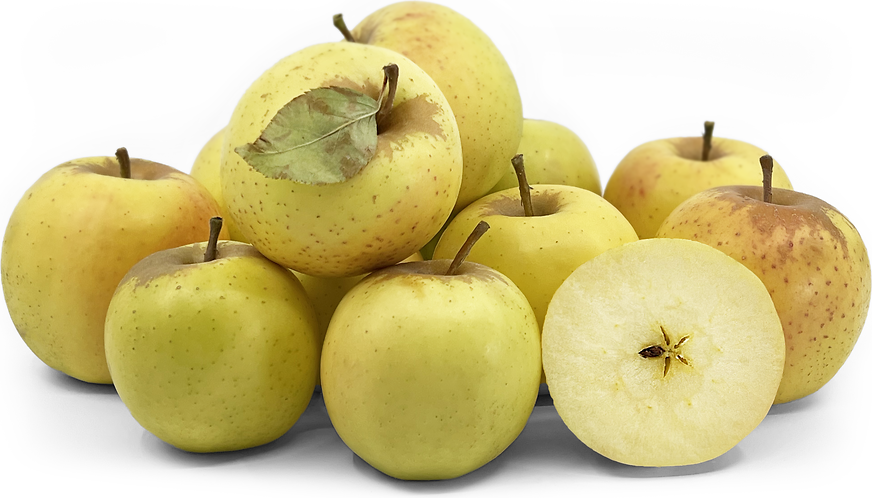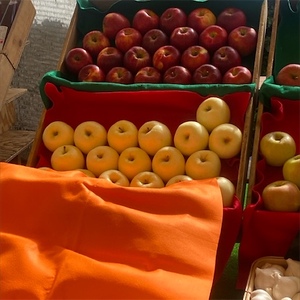


Shizuka Apples
Estimated Inventory, lb : 0
Description/Taste
Shizuka apples are a medium to large varietal, averaging 300 to 500 grams in weight, and have a round, conical, to oblate shape with flat shoulder tapering to a narrow base. The apple’s stem is elongated, slender, dark brown, and woody, connecting into a small cavity filled with grey-brown russet. The rough, textured russet often spills out over the apple’s shoulders, meeting the numerous raised lenticels scattered across the surface. The skin is thin, bruising and cracking easily, and has a smooth, satin-like feel, developing a waxy and greasy layer over time. The skin also ripens from green to golden yellow and is occasionally flushed with patches of faint red-orange blush. Underneath the skin, the light yellow flesh is fine to moderately coarse, firm, aqueous, and airy with a tender, crisp, and crumbly consistency. The flesh also encases a small central core filled with tiny black-brown seeds. Shizuka apples release a perfumed floral aroma with subtle spice notes when ripe. The flesh is high in sugar and low in acidity, creating a sweet, mild, and fruity taste with floral and tropical nuances.
Seasons/Availability
Shizuka apples are harvested in the fall, with a peak season in mid-October.
Current Facts
Shizuka apples, botanically classified as Malus domestica, are a Japanese variety belonging to the Rosaceae family. The late-season fruits were developed through a breeding program in the Aomori Prefecture in the late 20th century and were selected as a commercial cultivar for their sweet taste. Shizuka apples grow on spreading, upright, vigorous trees that produce large crops. The apples are somewhat resistant to powdery mildew and can be stored for extended periods. Shizuka apples are a triploid variety, meaning they have sterile pollen and cannot be used to pollinate other apple trees. In Japan, Shizuka apples are grown in limited quantities. The variety is not as popular as other commercial cultivars, but it is still produced on a small scale as a seasonal fresh-eating fruit. Outside of Japan, Shizuka apples are planted in specialty orchards in Europe and North America and are sold as a novelty.
Nutritional Value
Shizuka apples have not been extensively studied for their nutritional value. The variety is a source of potassium to balance fluid levels within the body, vitamin E to reduce inflammation, fiber to regulate the digestive tract, and vitamin C to boost the immune system. The apples also provide small amounts of copper to develop connective tissues, magnesium to control optimal nerve functioning, calcium to build strong bones and teeth, and other nutrients, including iron, vitamin K, manganese, and zinc.
Applications
Shizuka apples have a sweet flavor suited for fresh and cooked preparations. The variety can be consumed straight out of hand and is appreciated for its thin skin and crumbly flesh. Shizuka apples can also be sliced into salads, mixed into side dishes with fresh herbs, shredded into slaws, or candied and served as a sweet treat. Try serving Shizuka apples on cheese plates or using the apples as a fresh topping over parfaits, grain bowls, porridge, and pancakes. In addition to raw culinary dishes, Shizuka apples can be blended into smoothies, pressed into juices, or infused into syrups. They can also be skewered onto kebabs and are slow to brown, allowing them to be widely used in raw dishes. In Japan, Shizuka apples are cooked into a textured puree and are popularly made into applesauce. They are also incorporated into daifuku as a savory-sweet filling, baked into pies, cakes, and buns, or poached as a decadent dessert. Beyond sweet recipes, Shizuka apples can be cooked into Japanese curries, roasted with pork tenderloin, or sauteed with cabbage as a side dish. They can also be simmered into jams, jellies, and preserves or dried into strips for extended use. Shizuka apples pair well with other fruits such as apricots, strawberries, melons, or pears, cheeses including cheddar, parmesan, brie, or ricotta, spices such as cinnamon, ginger, cloves, and nutmeg, vanilla, and nuts including walnuts, pecans, or almonds. Whole, unwashed Shizuka apples will keep for 1 to 4 months when stored in a cool, dry, and dark location such as a cellar or refrigerator crisper drawer.
Ethnic/Cultural Info
The name Shizuka is derived from two Japanese words, “shizu,” meaning “quiet,” and “ka,” meaning “fragrance.” The apples were given their serene “quiet fragrance” moniker for their delicate, sweet, tropical scent and pleasant, mild taste. Shizuka apples share the same parentage as Mutsu apples, a well-known commercial Japanese variety. Mutsu and Shizuka apples were developed from a cross between Indo and Golden Delicious apples, and though they were developed several decades apart, they are considered sister varieties. It is important to note that though they share the same parentage, Shizuka apples are distinct from Mutsu apples and have varying flavors. Shizuka apples have a higher sugar content and less acidity, creating a sweeter, less balanced taste. Shizuka apples and Mutsu apples are both grown worldwide, but in Europe and the United States, Mutsu apples were rebranded under the name Crispin in 1968 to attract a broader consumer base.
Geography/History
Shizuka apples are native to Japan and were developed at the Aomori Research Station in Kuroishi city in the Aomori Prefecture. The variety was developed by breeder Mr. Tsuneo Murakami in 1969 and was created from a cross between Golden Delicious apples, an American variety, and Indo apples, a sweet Japanese variety from the 1930s. The apples were a part of the NE-183 series, and Mr. Murakami selected ten seedlings from his cross for further testing and evaluation. Of the ten seedlings, one seedling showed vigorous characteristics and was grafted in 1974. In 1977, the seedling produced fruits for the first time, and the apples were distinguished as a new variety, later named Shizuka. Shizuka apples were released to commercial markets in Japan in 1986 and were eventually introduced to European and American markets as a specialty cultivar. Today, Shizuka apples are cultivated on a small scale as a fresh-eating variety and are primarily grown and sold in Japan, Europe, and North America. When in season, Shizuka apples are found directly through growers, farmer’s markets, and select grocers.
Recipe Ideas
Recipes that include Shizuka Apples. One








